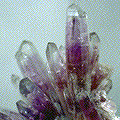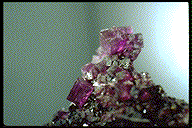MINERAL LOCALITY:
The Mines of Arizona
 |
 |
 |
 |
 |
 |
 |
 |
 |
 |
 |
 |
The typical Arizona copper deposits originate from the middle Mesozoic to early Cenozoic with igneous intrusions that are characterized as a porphyry copper. Although concentrated in Arizona similar intrusions produced ore deposits in New Mexico and Sonora, Mexico. The intrusions ran into a variety of host country rock and subsequent shrinking from cooling as well as other events; have fractured and brecciated the country rocks and even the intrusions themselves. These fractures, pores and other openings left ample avenues for hot hydrothermal fluids to move into the primary ore body. These fluids served to corrode and alter the rocks. Additionally, metamorphism created some skarn type deposits. Later fluids brought mineralization of still more sulfide and oxide ores. Finally, the typical ore bodies in Arizona were subjected to weathering at or near the surface of the Earth after eons of erosion removed overlying rocks. The weathering would remove much of the ore from the near surface rocks and leach them down to the groundwater interface where they would recrystallize as new minerals in an area called a supergene enrichment zone.
The variety of minerals that were produced through this sequence of events is mind numbing as well as mine enriching. The original intrusion brought an assortment of silicates as well as the copper containing sulfides chalcopyrite and bornite. Other sulfides and assorted minerals were also deposited with the original intrusions and later hydrothermal fluids. The metamorphism is responsible for much of the unique silicate assemblages where as the weathering and recrystallization produced most of the unique copper oxide, carbonate and sulfate mineralogy as well as some silicates, such as chrysocolla, and phosphates, such as turquoise. These weathered, colorful, near surface or surface deposits are called gangue deposits and although they are often not all that profitable themselves they do point prospectors to the potential riches below. The lower supergene enrichment zone produced economically valuable secondary sulfides such as chalcocite. A quick scan of the table below will show that sulfides and sulfates make up the majority of the mineral variety with a good assortment of all the other mineral classes.
The uranium and vanadium minerals of Arizona come from locations mostly in the Northern part of the state whereas the copper mines are generally limited to the southern portion. The minerals that are produced from these deposits are included in the table below with the copper mine minerals for a more complete look at the ore mineralogy of Arizona. Typically these minerals are phosphates, sulfates and oxides and form in sedimentary conditions. Buried wood is usually the progenitor of uranium and vanadium deposits. The rotting wood produces a reducing environment. Dissolved metals can then precipitate as groundwater fluids pass through this environment and are reduced. The deposits sometimes actually petrify the wood, forming fossils. Precipitation of silica from the fluids is of course famous for producing the world renown petrified forests.
Exploited even by early Native Americans, the mines of Arizona have provided the world with many wonderful specimens and all mineral collectors and mineralogists owe them a debt of gratitude. Besides the rare species, the fabulous individual examples of the more common minerals would give these mines a place onto the list of the world's greatest mineral localities. Above all else from this state are the specimens of azurite and malachite that adorn museum collections the world over.
The mines of Arizona have been known to produce specimens of:
- acanthite,
alabandite , bismuthinite, bornite, bournonite, calaverite, chalcocite, chalcopyrite, cinnabar, covellite,cupropavonite , digenite,djurleite , dyscrasite,empressite , enargite, galena, greenockite,henryite , hessite,kiddcreekite ,krennerite , molybdenite,petzite , pyrite, sphalerite, tennantite, tetrahedrite and wurtzite.
aravaipaite ,artroeite , atacamite, bideauxite,botallackite , boleite,bromargyrite , chlorargyrite,claringbullite , diaboleite, fluorite,iodargyrite ,laurelite ,matlockite ,nantokite ,paralaurionite ,paratacamite andyedlinite .
apachite , cassiterite,coronadite ,cryptomelane , cuprite,fairbankite , gibbsite, goethite,groutite , hematite, limonite, magnetite,murdochite ,navajoite ,paramelaconite , ramsdellite, rutile,tenorite and uraninite.
- andersonite,
aragonite,
aurichalcite,
azurite,
bayleyite , calcite, cerussite, dolomite,gerhardtite ,hydrocerussite , leadhillite, malachite, phosgenite, rosasite, smithsonite, susannite,swartzite and witherite.
- alunite,
anglesite,
antlerite,
barite,
brochantite,
butlerite , caledonite, chalcanthite,chalcoalumite ,chalcophyllite , connellite,coquimbite , crocoite,cuprotungstite , cyanotrichite,emmonsite , epsomite, ettringite,fornacite ,girdite , graemite,grandreefite ,guildite ,hemihedrite ,hexahydrite , jarosite,jurbanite ,khinite , linarite,mammothite ,nickel-zippeite ,oboyerite ,parakhinite ,pinalite ,pseudograndreefite ,rhomboclase ,rodalquilarite ,romerite , scheelite,schieffelinite ,sodium-zippeite , spangolite,voltaite ,wherryite ,winstanleyite , wolframite, wulfenite andzinc-zippeite .
bermanite , coconinoite,cornwallite , descloizite,dugganite ,duhamelite ,dumontite ,metatorbernite , mimetite, mottramite, pyromorphite, tsumebite,sengierite ,stolzite , turquoise and vanadinite.
- ajoite,
alamosite , albite, biotite, chlorite, chrysocolla,creaseyite , dioptase, epidote,gilalite ,halloysite , hemimorphite,hillebrandite ,junitoite , kinoite,luddenite ,macquartite , manganbabingtonite,maricopaite ,monticellite , muscovite, olivine, orthoclase, papagoite, plagioclase, plancheite, quartz,ruizite , shattuckite,stringhamite ,thaumasite , tourmaline,wickenburgite , willemite,xenotlite and zircon.










